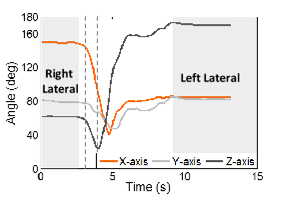




Did you find this useful? Give us your feedback


























51 citations
28 citations
...This is because both SleepHunter and SleepGuard employ the built-in microphone of the smartwatch which may be sensitive to the location of the smartwatch and the background noise of the environment....
[...]
...It is also observed that TagSleep achieves comparable accuracy with wearable sensor-based system (SleepGuard [8])....
[...]
...The existing works [6, 17, 32, 51, 58] recognized sleep sound-activities, such as snore and cough, mainly using sound data recorded by the bulit-in microphone in the smartphone (e.g., iSleep [23], Sleep hunter [22]), smartwatch (e.g., SleepGuard [8], ubiSleep [49]) and headband (e.g., Sleep Profiler [44])....
[...]
...(iii) For accelerometer-base approaches, most sensors are built in the smartphone (e.g., Sleep Cycle [13], Sleepbot [57] and S plus [44]), smartwatch (e.g., SleepGuard [8] and Sleepmonitor [59], SleepHunter [22], FitBit [18] and Jawbone [29]) and bed pad (e.g., Hoque et al. [24] and Beddit [6])....
[...]
...For cough activity, TagSleep outperforms SleepHunter and SleepGuard with the average accuracy improvement of 30% and 10%, respectively....
[...]
23 citations
20 citations
16 citations
23,155 citations
...The questionnaires were based on the Pittsburgh Sleep Quality Index (PSQI), a widely used and validated questionnaire in sleep quality research [16]....
[...]
21,674 citations
2,321 citations
...Such behaviors are most likely to occur during the deep sleep stage and the REM stage [8, 39]....
[...]
2,295 citations
...Traditionally, the dedicated medical technologies, like EEG, ECG and EMG [67], have been applied for sleep monitoring....
[...]
...This is because polysomnography monitors and analyzes sleep based on information that directly correlates with sleep such as EEG, EMG, EOG, and oxygen saturation, whereas SleepGuard estimates sleep quality from cues that have an indirect effect on sleep quality....
[...]
...Moreover, EMG and EOG using electrodes placed on the skin near the eyes and on the muscles, respectively, measures in deeply differentiating REM stage from all the other stages....
[...]
...In PSG, medical sensors attached to human body are used to monitor events and information such as respiration, electroencephalogram (EEG), electrocardiogram (ECG), electrooculogram and oxygen saturation [29, 44, 54, 67]....
[...]
1,918 citations
Exploring these techniques is part of their future work. This is where the authors need to measure and consider in their future work. Exploring such multi-sensor designs is an interesting future research direction. This will also be a direction for their future work.
multi-sensor designs, such as combination of smart watch and intelligent ring, could be used to gather relevant sensor measurements from both wrists.
For the hand position detection and micro-body movement detection (including the arm raising and hand movement), wearing the smartwatch on a different wrist does have an impact.
the user’s breathing patterns, posture during sleep, and routines surrounding the bedtime also have a significant impact on sleep quality.
Besides having an adverse effect on individuals, insufficient or poor quality sleep has a significant economic burden, among others, through decreased productivity, and medical and social costs associated with treatment of sleep disorders [47].
Examples of consumer-grade sleep monitors range from apps running on smartphones or tablets to smartwatches and specialized wearable devices [10, 32, 34, 58, 67, 69].
This is largely due to the upward facing direction of the palm when the hand is placed on the head compared to the downward palm direction when the hand is placed the other positions.
This is because current solutions focus on monitoring characteristics of the sleep itself, without considering behaviours occurring during sleep and the environmental context affecting sleep, e.g., ambient light-level and noise.
If their hierarchical model predicts that the hand was not placed on the head, the authors then use the method described in the next paragraph to detect if it was placed on the abdomen or the chest.
For this kind of situation, the authors can test the change of acceleration data in multi-sleeper situations by popularizing the experiment to adjust the detection threshold of their body’s micro movements and achieve better detection performance.
This is because PSG monitors and analyzes sleep based on information that directly correlates with sleep such as EEG, EMG, EOG, and oxygen saturation, whereas SLEEPGUARD estimates sleep quality from cues that have an indirect effect on sleep quality.
While the recognition performance of their system is very encouraging, there are some issues that would need to be addressed in their system before larger-scale deployment would be feasible.
In terms of errors, due to angular characteristics of acceleration being similar between the supine posture with hand putting on the head and the left-lateral posture, a small amount of the supine postures are classified as left lateral.